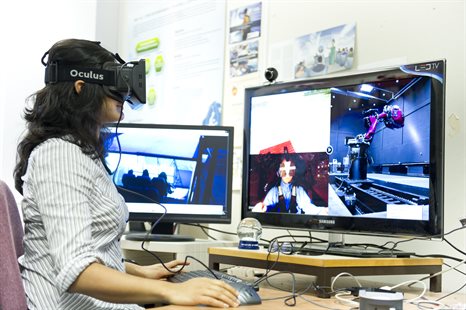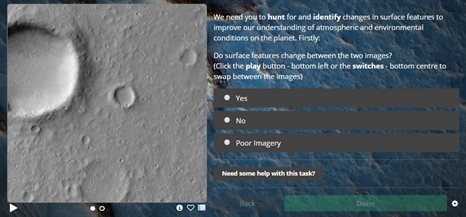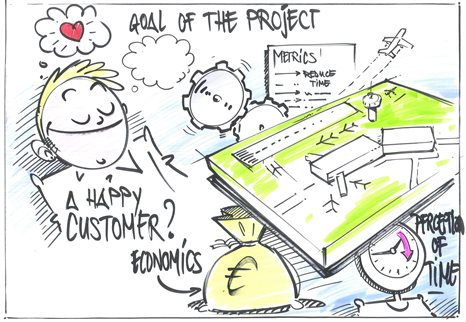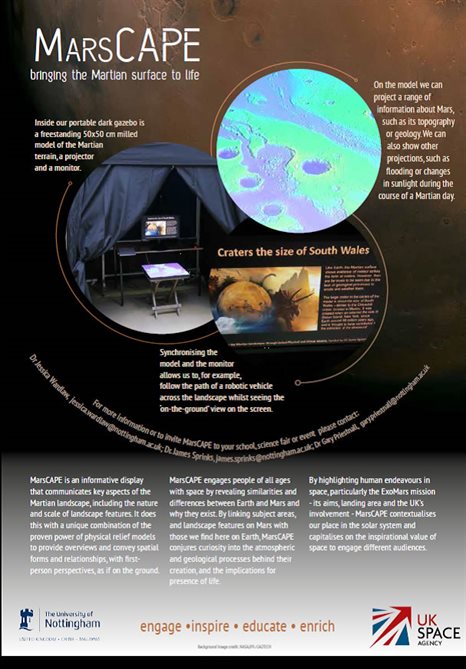Aerospace and Aviation
Consistent with taking a systems-based approach to ergonomics and human factors, HFRG carry out varied research across the aerospace and aviation area from studies of cockpit redesign and air-traffic controller workload through to consideration of ground operations and novel use of interactive technologies for passenger experience at airports and in the cabin. This has also been recently supplemented by work exploring the design of crowd-sourced analysis of Mars imagery that may eventually play a role in future missions to the red planet.
PhD Students
- Tamsyn Edwards (2013) Human performance in air traffic control. PhD thesis, University of Nottingham
- Laura Lewis (2015) Investigating the ways in which virtual environments could influence aircraft passengers' comfort and experiences. PhD thesis, University of Nottingham
- Adrian Marinescu (2018) Facial thermography for assemssment of workload in safety critaical environment.
Projects
- VR-HYPERSPACE: The innovative use of virtual and mixed reality to increase human comfort by changing the perception of self and space
Title: VR-HYPERSPACE: The innovative use of virtual and mixed reality to increase human comfort by changing the perception of self and space
Funder: European Commission Framework Programme 7 (AAT-285681)
Total value: €4,592,294.20
Start to end date: October 2011 – September 2014

Summary:
VR-HYPERSPACE was an ambitious 3-year European project (2011-2014) investigating the use of virtual reality (VR) and mixed reality (MR) to enhance passenger comfort in future aircraft in 2050 and beyond. “Positive illusions” were created with VR/MR, drawing on technology innovations and findings from neuroscience and the psychology of perception, to extend the experience of self and space. These illusions allow passengers to see themselves looking comfortable, feeling like they have more space around them in the cabin, or be in an alternative, more comfortable place, and carry out desired activities and social interaction with others.
Project partners:
- Fraunhofer Gesellschaft Zur Foerderung Der Angewandten Forschung E.V., Germany
- Teknologian Tutkimuskeskus Vtt, Finland
- Bauhaus-Universitaet Weimar, Germany
- Institute Of Communication And Computer Systems, Greece
- Universitat De Barcelona, Spain
- Max-Planck-Gesellschaft Zur Forderung Der Wissenschaften Ev, Germany
- Thales Alenia Space Italia Spa, Italy
- Airbus Defence And Space Gmbh, Germany
Key publications:
- Lewis, L., Patel, H., Cobb, S., D'cruz, M., Bues, M., Stefani, O. And Grobler, T., (2016) Distracting people from sources of discomfort in a simulated aircraft environment: Work, 54(4), 963-979
- D’Cruz M., Patel H., Lewis L., Cobb S., Bues M., Stefani O., Grobler T., Helin K., Viitaniemi J., Aromaa S., Frohlich B., Beck S., Kunert A., Kulik A., Karaseitanidis I., Psonis P., Frangakis N., Slater M., Bergstrom I., Kilteni K., Kokkinara E., Mohler B.J., Leyrer M., Soyka F., Gaia E., Tedone D., Olbert M. und Cappitelli M. (2014). VR-HYPERSPACE—The innovative use of virtual reality to increase comfort by changing the perception of self and space.IEEE Virtual Reality (VR 2014), Minneapolis, Minnesota
- D’Cruz, M., Patel, H., Lewis, L. and Cobb, S. (2014) Feedback on in-flight applications of virtual reality to enhance comfort in future aircraft. EuroVR 2014, Bremen, Germany, 8-10th December, 2014
- Frangakis, N., Karaseitanidis, G., D’Cruz, M., Patel, H., Mohler, B., Bues, M. and Helin, K. (2014) VR-HYPERSPACE Research Roadmap. Public Deliverable D6.4 of the FP7 VR-HYPERSPACE (AAT-285681) project (www.vr-hyperspace.eu)
- Aaltonen, L., Aromaa, S., Beck, S., Bergstrom, I., D'Cruz, M., Frangakis, N., Fröhlich, B., Helin, K., Kulik, A., Kunert, A., Lewis, L., Leyrer, M., Mohler, B., Patel, H., Soyka, F., Tedone, D., Viitaniemi, J. (2014) Final user evaluation report. Public Report D5.4 of the FP7 VR-HYPERSPACE (AAT-285681) project (www.vr-hyperspace.eu)
- D’Cruz, M. & Patel, H. (2013) VR-HYPERSPACE: Exploring new ways of enhancing comfort in future air travel using Virtual Reality (VR) and Mixed Reality (MR). Joint Virtual Reality Conference EGVE-ICAT-EuroVR, JVRC 2013, Paris, France
- Patel, H., Lewis, L., Cobb, S., D’Cruz, M, Tedone, D., Hakulinen, J. (2012) Report of current scenarios and case definition. Public Deliverable D1.1 of the FP7 VR-HYPERSPACE (AAT-285681) project (www.vr-hyperspace.eu)
VR-Hyperspace website
European Commission CORDIS: VR-HYPERSPACE Report Summary
Inflight VR simulation video

iMars: Analysis of Mars multi-resolution images using auto-coregistration, data mining and crowd source techniques
Title: iMars: Analysis of Mars multi-resolution images using auto-coregistration, data mining and crowd source techniques
Funder: European Project Framework Programme 7 (FP7 607379)
Total value: €2,014,171
Start to end date: December 2013 – March 2017
Summary:
The iMars project is applying the latest Big Data mining techniques to images captured of the surface of Mars over the last 40 years, so that they can be used to compute and classify changes in geological features. Images of the Martian surface reveal changes in features like sand dunes, dust devils, gullies and meteorite impact craters that further our understanding of the climate and geology of the planet. The Nottingham team is developing a Citizen Science platform, ‘Mars in Motion’, which will be used to both train and validate a computer algorithm to detect changes. Volunteers are asked to ‘spot-the-difference’ between two images, taken at different times, of locations where the algorithm thinks there has been change. Volunteers’ annotations on the images are aggregated until they reach a consensus, when their data will then be fed back to Planetary Scientists on the internet to inform future missions and research.
Project partners:
- University of Nottingham - Dr Steven Bamford and Professor Stuart Marsh
- University College London Mullard Space Science Laboratory (MSSL)
- Freie Universität Berlin (FUB)
- Deutsche Zentrum für Luft- und Raumfahrt (German Aerospace Centre/DLR)
- École Polytechnique Fedérale de Lausanne; University of Seoul.
Key publications:
- HOUGHTON, RJ, WARDLAW, J, SPRINKS, J, GIORDANO, M, BAMFORD, S and MARSH, S, 2016. Martian Factors: A systems ergonomics approach to citizen science In: Human Factors In Complex Systems 2016.
- MULLER, J. P., TAO, Y., SIDIROPOULOS, P., GWINNER, K., WILLNER, K., FANARA, L., WAEHLISCH, M., VAN GASSELT, S., WALTER, S., STEIKERT, R., SCHREINER, B., IVANOV, A., CANTINI, F., WARDLAW, J., MORLEY, J., SPRINKS, J., GIORDANO, M., MARSH, S., KIM, J., HOUGHTON, R. and BAMFORD, S., 2016. EU-FP7-IMARS: Analysis of Mars multi-resolution images using auto-coregistration, data mining and crowd source techniques: Processed results - A first look
- SPRINKS, J, WARDLAW, J, HOUGHTON, RJ, BAMFORD, S and MARSH, S, 2016. Better the Martian you know?: Trust in the crowd vs. trust in the machine when using a Martian Citizen Science platform In: 11th European Planetary Science Congress (EPSC).
- WARDLAW, J, SPRINKS, J, HOUGHTON, RJ, BAMFORD, S, MARSH, S, MULLER, J-P and SIDIRPOULOS, P, 2016. Mars in Motion: An online Citizen Science platform looking for changes on the surface of Mars In: 11th European Planetary Science Congress (EPSC)
- MULLER, J-P, SIDIRPOULOS, P, TAO, Y, WILLNER, K, WAEHLISCH, M, WALTER, S, SCHREINER, B, STEIKERT, R, IVANOV, A, CANTINI, F, SPRINKS, J, GIORDANO, M, KIM, J, HOUGHTON, RJ and BAMFORD, S, 2016. EU-FP7-iMARS: Analysis of Mars multi-resolution images using auto-coregistration, data mining and crowd source techniques: A Status Report. In: 11th European Planetary Science Congress (EPSC)
- SPRINKS, J, HOUGHTON, RJ, BAMFORD, S and MORLEY, J, 2015. Citizen science: The importance of being needed and not wasted In: The ACM SIGCHI Annual Symposium on Computer-Human Interaction in Play (CHI PLAY 2015).
- WARDLAW, J, SPRINKS, J, HOUGHTON, RJ, BAMFORD, S, MORLEY, J and MARSH, S, 2015. iMars: Crowd-sourced analysis of imagery for geological change on Mars. In: GRSG 26th Annual Conference "Challenges in Geological Remote Sensing", Frascati, Italy.
- MULLER, J-P, GWINNER, K, VAN GESSELT, S, IVANOV, A, MORLEY, J, HOUGHTON, RJ, BAMFORD, S, YERSHOV, V, SIDIRPOULOS, P and KIM, J, 2014. EU-FP7-iMars: Analysis of Mars Multi-Resolution Images using Auto-Coregistration, Data Mining and Crowd Source Techniques: An overview and a request for scientific inputs In: Geophysical Research Abstracts. 16. EGU2014-13744
i-Mars

PASSME: Personalised Airport Systems for Seamless Mobility and Experience
Title: PASSME: Personalised Airport Systems for Seamless Mobility and Experience
Funder: Horizon 2020 Funding (MG-636308)
Total value: €4,639,086.25
Start to end date: June, 2015 – May, 2018
Summary:
PASSME's principal objective is to reduce door-to-door air travel time by 1 hour. Air Traffic is projected to grow by 4.7% annually between 2013-2023. PASSME will provide industry-driven passenger-centric solutions to address this challenge. PASSME development span across the following innovations:
- enhancing overall passenger experience at airports and reducing stress through a personalised device,
- improving luggage handling processes,
- forecasting passenger flow and
- improving airport and aircraft interiors
PASSME researchers investigate critical bottlenecks in the airport experience, including mobility for those passengers with disabilities and young children, boarding and overall passenger flow. The outcomes of PASSME will benefit the entire aviation community including passengers, airlines and airports and will create a communication links amongst all these stakeholders.
HFRG members:
Project partners:
- Delft University of Technology (Project Coordinator), The Netherlands
- Optimares SpA, Italy
- Netherlands Aerospace Centre, The Netherlands
- KLM Royal Dutch Airlines, The Netherlands
- Schiphol Airport Amsterdam, The Netherlands
- German Aerospace Centre, Germany
- Hamburg Airport, Germany
- Technical University Hamburg, Germany
- Alma Design, Spain
- Carr Communications, Ireland
- Institute of Communication and Computer Systems, Greece
Key publications:
- KEFALIDOU, G., D'CRUZ, M., SHARPLES, S., DE LILLE, C., FRANGAKIS, N., OTTENS, R., GROSMANN, R., MARCELINO, R., LÜTJENS, K., LÖWA, S., SHAW, E., NARDINI, A. and SANTEMA, S., 2016. Passengers' Requirements for developing a Passenger-Centred Infrastructure to Enhance Travel Experiences at Airports In: Ergonomics and Human Factors 2016. (CIEHF 2016),
- FEI, T., De JOUX, N., KEFALIDOU, G., D'CRUZ, M., SHARPLES, S. (2016). Towards Understanding Information Needs and User Acceptance of Mobile Technologies to Improve Passenger Experience in Airports, European Conference in Cognitive Ergonomics (ECCE) 2016
- De JOUX, N., KEFALIDOU, G., D'CRUZ, M., SHARPLES, S. (2016). Human Factors Issues in Interpreting Physiological Measurements in Complex Socio-technical Systems, In Proc. Human Factors in Complex Systems, Nottingham, UK
- KEFALIDOU, G., D'CRUZ, M., SHARPLES, S., MISICHRONI, F., FRANGAKIS, N. AND KARASEITANIDIS, I. (2017) Opportunities and Challenges for Mobile Technologies and Intelligent Mobility: When the border between data collection and ‘living’ data is merging, In Proceedings of 49th Annual Universities Transport Study Group (UTSG) Conference, Dublin, Ireland, 4-6 January. (UTSG 2017)
- De JOUX, N., KEFALIDOU, G., D'CRUZ, M., SHARPLES, S., MISICHRONI, F., KARASEITANIDIS, I. AND FRANGAKIS, N. (to appear - 2017). Identifying Requirements for Mapping Physiological Measurements to Distress. In Proceedings of the Ergonomics & Human Factors 2017 Conference, 25th- 27th April, 2017, Daventry, Northamptonshire. CIEHF 2017 (to be presented)
- KEFALIDOU, G. (2016). Understanding Passenger Experience from Kerb to Gate, EU Door-to-Door Mobility Workshop, University of Westminster, 12 July 2016, London.
- KEFALIDOU, G. (2017 - to be presented). Changing the Travel Experience, Architecture of Air Travel: Designing for Human Behaviour, Royal Aeronautical Society Conference, 24th and 25th April 2017, London.
European Commission CORDIS: PASSAME project details
PASSME

Human Integration with Navigable Taxiway Sequencing (HINTS)
Title: Human Integration with Navigable Taxiway Sequencing (HINTS)
Summary:
The European airspace is experiencing an increase in demand for its capacity, and forecasts predict that flight demand will grow 1.5 times between 2012 and 2035 (SESAR, 2015). As more flights take to the sky, capacity is also becoming constrained in airports at ground level. Optimal routing of aircraft throughout an airport requires an air traffic controller (ATCO) to consider the needs of multiple aircraft concurrently, potentially increasing workload and cognitive demands. However, while human operators can only consider a limited number of traffic routing combinations, optimization-based decision support systems may overcome this limitation and provide guidance on optimal routes and schedules.
HINTS investigates the role of optimization-based decision support technology in ATCO decision making and performance, drawing upon perspectives in human factors, operations research, and geospatial positioning. The primary aim is to develop a decision support tool for directing aircraft taxiway movements that also reduces workload and enhances situation awareness for end users.
Project partners:
- Jason Atkin, Computer Science, University of Nottingham
- Geert de Maere, Computer Science, University of Nottingham
- Terry Moore, Nottingham Geospatial Institute, University of Nottingham
- Herve Morvan, Institute for Aerospace Technology, University of Nottingham
Institute for Aerospace Technology
eATM Portal
